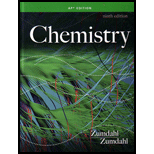
Concept explainers
(a)
Interpretation: The authenticity of the given statements is to be determined.
Concept introduction: Structural isomerism is defined as a form of isomerism in which molecules have the same molecular formula but differ in their bonding patterns and atomic structure.
There are four types of structural isomerism named as: chain isomerism, position isomerism,
To determine: The authenticity of the given statement.
(b)
Interpretation: The authenticity of the given statements is to be determined.
Concept introduction: Structural isomerism is defined as a form of isomerism in which molecules have the same molecular formula but differ in their bonding patterns and atomic structure.
There are four types of structural isomerism named as: chain isomerism, position isomerism, functional group isomerism and tautomerism.
To determine: The authenticity of the given statement.
(c)
Interpretation: The authenticity of the given statements is to be determined.
Concept introduction: Structural isomerism is defined as a form of isomerism in which molecules have the same molecular formula but differ in their bonding patterns and atomic structure.
There are four types of structural isomerism named as: chain isomerism, position isomerism, functional group isomerism and tautomerism.
To determine: The authenticity of the given statement.
(d)
Interpretation: The authenticity of the given statements is to be determined.
Concept introduction: Structural isomerism is defined as a form of isomerism in which molecules have the same molecular formula but differ in their bonding patterns and atomic structure.
There are four types of structural isomerism named as: chain isomerism, position isomerism, functional group isomerism and tautomerism.
To determine: The authenticity of the given statement.
(e)
Interpretation: The authenticity of the given statements is to be determined.
Concept introduction: Structural isomerism is defined as a form of isomerism in which molecules have the same molecular formula but differ in their bonding patterns and atomic structure.
There are four types of structural isomerism named as: chain isomerism, position isomerism, functional group isomerism and tautomerism.
To determine: The authenticity of the given statement.
Want to see the full answer?
Check out a sample textbook solution
Chapter 22 Solutions
Chemistry (AP Edition)
- What is the product of the reaction? F3C. CF3 OMe NaOH / H₂Oarrow_forwardWhat would you expect to be the major product obtained from the following reaction? Please explain what is happening here. Provide a detailed explanation and a drawing showing how the reaction occurs. The correct answer to this question is V.arrow_forwardPlease answer the question for the reactions, thank youarrow_forward
- What is the product of the following reaction? Please include a detailed explanation of what is happening in this question. Include a drawing showing how the reagent is reacting with the catalyst to produce the correct product. The correct answer is IV.arrow_forwardPlease complete the reactions, thank youarrow_forwardConsider the synthesis. What is compound Y? Please explain what is happening in this question. Provide a detailed explanation and a drawing to show how the compound Y creates the product. The correct answer is D.arrow_forward
- What would be the major product of the following reaction? Please include a detailed explanation of what is happening in this question. Include steps and a drawing to show this reaction proceeds and how the final product is formed. The correct answer is B. I put answer D and I don't really understand what is going on in the question.arrow_forwardWhat is the product of the following reaction? Please explain what is happening in this question. Provide a detailed explanation and a drawing showing how the reagent is reacting with the catalysts to product the correct product. The correct answer is B.arrow_forwardWhat is the missing intermediate 1 and the final product 2. Please include a detailed explanation explaining the steps of malonic ester synthesis. Please include drawings of the intermediate and how it occurs and how the final product is former.arrow_forward
- What would be the reagents and conditions above and below the arrow that will complete the proposed acetoacetic ester synthesis? If it cannot be done efficiently, then I will choose that answer. There could be 2 or 4 reagents involved. Please provide a detailed explanation and drawings showing how it would proceed with the correct reagents.arrow_forwardFor benzene, the ∆H° of vaporization is 30.72 kJ/mol and the ∆S° of vaporization is 86.97 J/mol・K. At 1.00 atm and 228.0 K, what is the ∆G° of vaporization for benzene, in kJ/mol?arrow_forwardThe reaction Q(g) + R(g) → Z(l) is shown to be exothermic. Which of the following is true concerning the reaction. it is spontaneous only at High T, it is spontaneous at low T it is nonspontaneous at all T it is spontanrous at all T. it is non spontaneous only at low T.arrow_forward
 Chemistry for Today: General, Organic, and Bioche...ChemistryISBN:9781305960060Author:Spencer L. Seager, Michael R. Slabaugh, Maren S. HansenPublisher:Cengage Learning
Chemistry for Today: General, Organic, and Bioche...ChemistryISBN:9781305960060Author:Spencer L. Seager, Michael R. Slabaugh, Maren S. HansenPublisher:Cengage Learning World of Chemistry, 3rd editionChemistryISBN:9781133109655Author:Steven S. Zumdahl, Susan L. Zumdahl, Donald J. DeCostePublisher:Brooks / Cole / Cengage Learning
World of Chemistry, 3rd editionChemistryISBN:9781133109655Author:Steven S. Zumdahl, Susan L. Zumdahl, Donald J. DeCostePublisher:Brooks / Cole / Cengage Learning Introductory Chemistry: A FoundationChemistryISBN:9781337399425Author:Steven S. Zumdahl, Donald J. DeCostePublisher:Cengage Learning
Introductory Chemistry: A FoundationChemistryISBN:9781337399425Author:Steven S. Zumdahl, Donald J. DeCostePublisher:Cengage Learning Introductory Chemistry: A FoundationChemistryISBN:9781285199030Author:Steven S. Zumdahl, Donald J. DeCostePublisher:Cengage Learning
Introductory Chemistry: A FoundationChemistryISBN:9781285199030Author:Steven S. Zumdahl, Donald J. DeCostePublisher:Cengage Learning Introductory Chemistry: An Active Learning Approa...ChemistryISBN:9781305079250Author:Mark S. Cracolice, Ed PetersPublisher:Cengage Learning
Introductory Chemistry: An Active Learning Approa...ChemistryISBN:9781305079250Author:Mark S. Cracolice, Ed PetersPublisher:Cengage Learning





